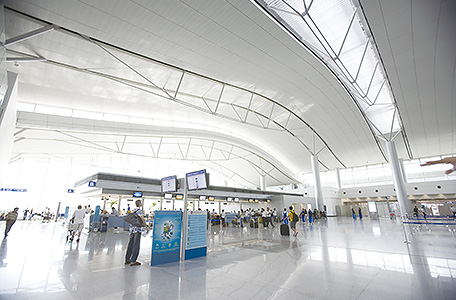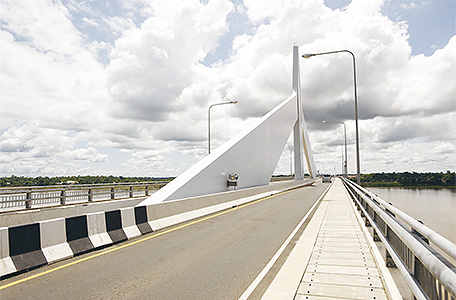Japan's Official Development Assistance White Paper 2013
ODA Topics 02
Making ODA Loans More Effective
“ODA loans” is a term referring to cooperation given in the form of development loans for developing countries with low interest rates, a long payment period, and relaxed conditions (concessional conditions). Such loans are given with the objective of helping recipient countries create the socio-economic infrastructure needed to establish economic independence. Loans are also expected to encourage a self-help mentality within each country through the fulfilment of repayment obligations.
In April 2013, a new policy was announced that utilizes the strengths of Japan and makes ODA loans even more attractive from the perspective of developing countries, the “Improvement Measures for the Strategic Use of ODA Loans.” The aim of these measures are to provide developing countries with Japan’s advanced technology and experiences while allowing Japan to share in the success of the emerging economies in Asia in particular, which already have a close relationship with Japan, by facilitating ODA loans strategically such that they vitalize the Japanese economy. Two specific initiatives of the Improvement Measures shall be introduced in this column.
■ Further Utilizing the Technology of Japan
In order to promote the “visibility of Japanese Aid” through technology transfers to developing countries, in 2002 Japan introduced “Special Terms for Economic Partnership (STEP),” under which loans are be used for orders from Japanese companies.
For STEP projects, a Japanese company must serve as the general contractor and 30% or more of the materials and equipment used in the project must come from Japan (the Japanese procurement rate). There were concerns initially that STEP would push project costs too high for developing countries; however, the international business environment has greatly changed in the past ten years. Japanese companies have made progress on operations in overseas markets, such that many manufacturers now have production centers set up in each region. For instance, it is now even possible for companies to produce products intended for the African market in the United Kingdom. And although STEP involves an ODA loan to support the development of a developing country via a Japanese company, the definition of “Japanese company” is changing. Through such measures as the expansion of the definition of “general contractors” to include subsidiaries of Japanese companies based overseas and the reconfiguration of the calculation rules determining the Japanese procurement rate such that procurements from overseas subsidiaries can be counted as Japanese products, recent systematic reforms have expanded the definition of “Japanese company.” All of this has been done in the aim of providing a greater variety of companies with the opportunity to bid on projects. As a result of these initiatives, the number of companies bidding for STEP projects has increased and the principle of competition has functioned. Moreover, by making it possible for companies to procure materials in not only domestic but also international markets, the project production and transportation costs have been lowered, making it possible for companies to realize even lower bids. It is expected that this trend will assuage the concerns of developing countries about the need to pay back high costs.
Since STEP projects are expected to incur orders from Japanese companies, they spur domestic demand and job creation. For instance, an ODA loan of approximately ¥140 billion for a certain international port development project is expected to have a demand creation effect in the Japanese economy valued at approximately ¥187.6 billion and a domestic job creation effect totaling approximately 12,000 people. In this way, ODA loans not only support economic growth in developing countries, but they also vitalize the Japanese economy.

The Tan Son Nhat International Airport in Ho Chi Minh City, Viet Nam, constructed through an ODA Loan (Photo: Shinichi Kuno / JICA)
■ Stand-by Emergency Credit for Urgent Recovery (SECURE)
Japan has set a policy of mainstreaming disaster risk reduction in development assistance and is leading efforts in the international community to that end. Among the support given to developing countries in the past after a disaster has taken place has been emergency support for the period directly after the disaster (Emergency Grant Aid, etc.) and support for infrastructure construction during the reconstruction stage (ODA loans). The establishment of Stand-by Emergency Credit for Urgent Recovery (SECURE) thus introduces a new framework that can directly respond to the demand for funds at the time of recovery, creating a bridge between emergency support and reconstruction. After a disaster occurs, countries estimate the amount of funding they will need and then request those funds from overseas. This can lead to the creation of a large burden for developing countries. Moreover, this process requires a lot of time, as the supporting side too will need to conduct a certain amount of domestic discussion before funds can be disbursed.
Nevertheless, following a disaster there is urgent need for the commodities required during the recovery stage (foods, fuel, etc.) and infrastructure (simple waterways, the recovery of small-scale roads and temporary housing). While countries wait for such support, lives hang in the balance. That’s why Japan is signing ODA loan agreements ahead of time with developing countries that expect natural disasters to occur in the future, and why a framework has been drawn up that will make the swift lending of funds possible if a disaster does occur. Furthermore, with the understanding that it is vital that the damage caused by disasters be minimized, in order to bolster responsiveness towards disasters, the Japanese government has made it possible to advance ODA loans in combination with technical cooperation to strengthen disaster management capabilities. Japan aims to enhance disaster responsiveness in developing countries through sharing its own experiences as a country affected by natural disasters.
These initiatives are just some of the measures that Japan is undertaking in order to properly address the needs of developing countries in Asia and elsewhere, and to encourage growth within those countries and Japan as well. The Japanese government will continue to move forward with constant improvement efforts towards the realization of ever more effective ODA loans.

The Second Mekong International Bridge, constructed through an ODA Loan (Second Mekong International Bridge Construction Project), connects Thailand and Laos, spanning a distance of approximately 1,600 m (Photo: Yasuhiko Okuno / JICA)
